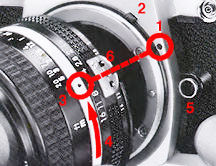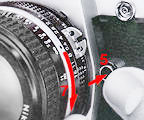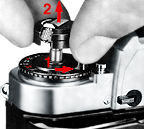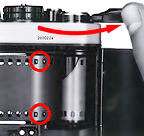Although the FA shares the same F-mount but there are some modification done with the lenses before the FA was made available. Don't worry, the mount still takes older lenses (Even with the latest AF Nikkor), only compromise is you may not be able to take the FA to full flight in all the automatic features provided. But good news is, the FA needs only a minimum specification of an AI modified Nikkor lens to work.
Oh, that is one more thing, since the Nikon F mount was first introduced in 1959 in the Nikon F camera, it has gone through some changes in upgrading. In 1977, all Nikkor lenses were made to have automatic indexing (AI). The very old Nikkor lenses, however needs to do a AI conversion before they can be used in automatic indexing in the FA. This was attributed to the decision of having a fixed meter coupling lever in the lens mount (Thus, the familiar tiny retractable meter coupling lever release button just next to the lens mounting index has been removed).
 |
When mounting a lens to the camera, first, line up the aperture/distance index on the lens (3) with the lens mounting index on the camera body (1). Then twist the lens mounting ring counterclockwise (4) until the lens clicks into place. Confirm that the aperture/distance index is right on top. The FA comes with a fixed meter coupling lever (2), thus, only AI, AIS or current AF lenses can be used with the Automatic Indexing feature. |
To change a lens, while pushing the lens release button (5), turn the lens mounting ring clockwise (7) until it reaches the lens mounting index mark (1) and you can lift the lens off. Be very careful when you are changing lenses with film loaded in the camera, be careful not to expose the mirror box to direct sunlight. |
 |
It is not a good idea to load a film into your camera immediately when you had a camera back from the shop. Always take sometime to get familiar with the operations and controls before you do that. But should you need to do so, you need to open the camera back. Every camera manufacturers design their way of opening the back in a universal manner, except during the early days of trying and searching for the most functional, responsive and safest way for users. For instance, the early Nikkormat cameras have their back opening lever at the lower portion of the camera which you may spend sometime to locate.
However, the FA, as with many other Nikon bodies, the opening of the filmback has a safety lock. Locates at the center of a large ring (the Exposure compensation/ISO filmspeed dial) on the left hand side of the camera. First you need to push the camera back lock lever (1) counterclockwise with your finger, pull up the film rewind knob (2). Then lift up further until the camera back pops open. The safety lock feature is designed to prevent accidental opening of the camera back. |
 |
With the back opened, you may load a film into the film chamber. Pull the film leader and insert the film leader in the takeup spool. Pull the leader across the camera and insert it into any one of the slots in the takeup spool. BUT caution: After the back is open, you must be extremely careful NOT to touch the exposed shutter blades/curtain especially with the film running across and covered the curtain (When you may forget the shutter is just right undernealth the film), the curling film leader when first pull out from the film catridge also may easily scratch across the thin layer of shutter blades. I have seen too many careless handling resulting in damaged or deformed shutter curtain, this applies on any cameras. Although the auto film advancing features available in most modern cameras make this a less daunting experience. NEVER attempt to use any force if you load the film unsuccesully.
 |
Make sure that the perforations along the edges of the film mesh with the sprockets. If necessary, release the shutter by pushing the shutter release button, and stroke the film-advance lever slowly to make sure that the leader winds smoothly on the spool and that the film edge perforations engage the film sprocket roller. When you are certain that the film is being fed properly onto the spool and traveling correctly along the film guide rails, close the camera back by pressing it until it snaps into place. |
There is only one way to test for
proper film advancement. You should confirm proper loading to avoid unnesssary "embarrassment"
after finishing your photo session at frame 37+ or worst still, presenting blank
and unexposed roll later for processing. To confirm, just fold out the rewind crank
and turn it in the direction of the engraved arrow indicates until some resistance
is felt. Now, if the film is properly advanced by take a look at the rewind lever
(2) will rotate when you advancing a frame
or two (1) before setting on course to the frame
number "1".
 |
Up to this point, the Nikon FA was indeed packed with some very considerate features. First, the camera will automatically set the shutter to 1/250 sec manually during the initial first few frames until you reach frame number 1 in the exposure counter. This also apply when you have any dedicated Nikon flash mounted on the camera. |
Most of the earlier
Nikon bodies like the earlier automatic Nikkormats, and the FE camera were not equipped
with this feature and thus. If accidentally you have your lens cap on your lens or
trip the shutter in a dark environment, the shutter may assume it is very dark and
the automatic exposure will determine by the wrong reading and set a extra long exposure.
You have to turn the shutter speed ring to the manual shutter or the mechanical back
up speed of M250 before the shutter will release.
After making sure the film is correctly taken up (By watching the rewind knob turn
(2)), few blank exposures will advance the
film to counter "1," and fresh film inside the camera is ready to be exposed.
| Back | Next | 2/13
parts
|
Back | to Main Index Page of Nikon
FA
Other Technical
Issues
Relating to Nikon FA
Camera Instruction
Manual - HTML | PDF
(1.4 MB)
Main Reference
Map for Body -
HTML | PDF
(731k)
Specifications - HTML
| PDF (245k)
The AI-S Nikkors (related info | TTL OTF Flash Metering | Interchangeable Focusing Screens. The MD-15/MD12/MD11 Motor Drives | 3rd party Power Winder (new) | Flash Units - | SB-15 | SB-10 | SB-16B & Other Options | Databacks | Titanium Shutter | Variation : Mr Y K Wong from Singapore contributing 11 images of his Nikon FA GOLD
| Nikon FM series |
Nikon FE series |
Nikon
FA |
W A R N I N G: The New G-SERIES Nikkor lenses have no aperture ring on the lens, they CANNOT ADJUST APERTURES with any of these manual focus Nikon FE series SLR camera models; please ignore some portion of the content contained herein this site where it relates.
| Message Board | for your favourite Nikon FA camera
| Message Board | for your Nikon Optics in a shared environment
| Message Board | Specifically for Dispose or Looking for Nikon / Nikkor Photographic Equipment
Shared Resources: MD-11 | MD-12 | 3rd Party Power Winder Only for FM2(n)/FE2/FA | Focusing Screens | Titanium Shutter | Flash Units - | SB-15 | SB-10 | SB-16B & Other Options | Databack | Nikkor lens mount (related info)
Others:- Nikon AF-TTL Speedlights | SB-20 (1986) | SB-22 (1987) | SB-23 | SB-24 (1988) | SB-25 (1991/2) | SB-26 (1994) | SB-27(1997) | SB-28 (1997) | Nikon SB-29(s) (2000) | Nikon SB-30 (2003) | Nikon SB-600 (2004) | Nikon SB-800 (2003) Nikon AF-TTL Speedlight DX-Series: Nikon SB-28DX (1999) | SB-50DX (2001) | SB-80DX (2002)
Nikon
BC-flash Series |
Original
Nikon Speedlight
SB-2
| SB-3 | SB-4
| SB-5
| SB-6 | SB-7E
| SB-8E
| SB-9 | SB-E
| SB-10
SB-11
| SB-12 | SB-14 | SB-140 UV-IR| SB-15 | SB16A | SB-17 | SB-18, SB-19 | SB-21A (SB-29) Macro flash | Flash Accesories | SF-1
Pilot Lamp
| Nikon F | Nikon F2 | Nikon F3 | Nikon F4 | Nikon F5 | Nikon F6 | Nikkormat / Nikomat | Nikon FM | Nikon FE/ FA | Nikon EM/FG/FG20 | Nikon Digital SLRs | Nikon - Other models |
Nikon Auto Focus Nikkor lenses:- Main
Index Page
Nikon Manual Focus Nikkor lenses:- Fisheye-Nikkor Lenses - Circular | Full Frame |
Ultrawides Lenses - 13mm15mm18mm20mm | Wideangle Lenses - 24mm28mm35mm | Standard Lenses - 45mm 50mm 58mm | Telephoto
Lenses - 85mm105mm135mm180mm & 200mm | Super-Telephoto Lenses - 300mm 400mm 500mm 600mm 800mm 1200mm |
 Index Page |
Special
Application lenses: Micro-Nikkor Lenses - 50mm~55mm -60mm 85mm -105mm 200mm Micro-Zoom 70-180mm Perspective Control (PC) - 28mm 35mm PC-Micro 85mm Dedicated Lenses for Nikon F3AF: AF 80mm f/2.8 | AF 200mm f/3.5 EDIF Depth of Field Control (DC): 105mm 135mm Medical Nikkor: 120mm 200mm Reflex-Nikkor Lenses - 500mm 1000mm 2000mm Others: Noct Nikkor | OP-Nikkor | UV Nikkor 55mm 105mm | Focusing Units | Bellows-Nikkor 105mm 135mm Nikon Series E Lenses: 28mm35mm50mm100mm135mm | E-Series Zoom lenses: 36~72mm75~150mm70~210mm |
MF Zoom-Nikkor Lenses: 25~50mm | 28~45mm | 28~50mm | 28~85mm | 35~70mm | 36~72mm E | 35~85mm | 35~105mm | 35~135mm | 35~200mm | 43~86mm | 50~135mm | 50~300mm | 70~210mm E | 75~150mm E | 80~200mm | 85~250mm | 100~300mm | 180~600mm | 200~400mm | 200~600mm | 360~1200mm | 1200~1700mm
Tele-Converters: TC-1 | TC-2 | TC-200 | TC-201 | TC-300 | TC-301 | TC-14 | TC-14A | TC-14B | TC-14C | TC-14E | TC-16 | TC-16A | TC-20E
Recommended links to understand more technical details
related to the Nikkor F-mount and production Serial Number:
http://rick_oleson.tripod.com/index-153.html by: my
friend, Rick Oleson
http://www.zi.ku.dk/personal/lhhansen/photo/fmount.htm by: Hansen,
Lars Holst
http://www.mir.com.my/rb/photography/hardwares/nikonfmount/lens2.htm
http://www.photosynthesis.co.nz/nikon/serialno.html
|
Back | Main Index Page of Nikkor Resources
|
Back | Main Index Page of Pictorial
History of Nikon SLRs
| Message Board | for your Nikkor optics ("shared" because I do wish some of you to expose to other's perspective as well. Isn't it a sad sate to see photography has to be segmented into different camps from the use of various labels)
about this photographic web site
Home - Photography in Malaysia |
A contributing effort to Michael C Liu's Classic Nikon Site.
Credit: Chuck Hester for some of his beautiful images used in this site; Ted Wengelaar®, Holland for his continuous flow of input; Lars Holst Hansen, Danish 'Hawkeye' who shares the same passion; Mr Poon from Poon photo for their input; Ms Miss Rissa (Sales Manager) & members of the Technical Service dept. of Shriro Malaysia, local distributor of Nikon cameras in Malaysia & Singapore, in providing so many useful input to make this site possible. Special thanks to Mr MC Lau, who has helped with his images of the MF-12 databack. Michael Tan, Pertama Photo (603-2926505) for lending his original Titanium Shutter Display Unit. Dave Hoyt who has prepared the introductory page and offer some images of his FE2 in this site.. Hiura Shinsaku, Nikomat ML, Japan for his contribution on all the various images; A contributing site to a long lost friend on the Net. Note: Certain content and images appeared in this site were either scanned from official marketing leaflets, brochures published by Nikon and/or contribution from surfers who claimed originality of their own work to publish in this site based on educational merits. The creator of this site will not be responsible for any discrepancies that may arise from such possible dispute except rectifying them after verification."Nikon", "Nikkormat", "Nippon Kokagu KK" & "Nikkor" are registered tradename of Nikon Corporation Inc., Japan. Made witha PowerMac.